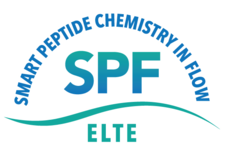High performance peptide synthesizer
HPPS-4000
Continuous flow solid phase peptide synthesis
The high pressure and high temperature in the continuous flow reactor ensure excellent conversion in a short reaction time and using a relatively low amino acid excess. The synthesis is carried out in a continuous flow cell on a column filled by a special solid support. The system is being built up using JASCO LC-4000 HPLC modules providing the appropriate pressure, temperature and solvent resistance.
The pump delivers the steady and high pressure liquid flow. N,N-dimethylformamide (DMF) can be typically used both as reaction medium as well as resin washing fluid. An HPLC autosampler is utilized for the injection of coupling and deprotection mixtures into the flow-line, these pass through the reactor as plugs. The high volume precision of the injection ensures excellent reproducibility. Premixed coupling mixtures are also suitable, but the programmable autosampler is capable to do in situ mixing and delivering of reagents. Performing the mixing steps immediately before the coupling minimizes the possibility of racemisation and decomposition of the activated amino acids. By changing the flow rate the residence time can be influenced, while the fine-tuning of the temperature allows high conversion values and reduced side-product formation. A back-pressure regulator provides the constant pressure in the reactor cell.
The entire synthesis is automated and computer controlled. The flow rate, temperature, duration of the individual reaction steps, the amino acid sequence
and injected volumes are settable in the ChromNav2 software. Selected users receive e-mail notification about eventual malfunctions or at the end of the synthesis process.
The system, by addition of an optional detector, can be utilised as an HPLC system for the purification or analysis of the synthesized products. An other option can be a solvent recycling valve system, by the use of which the coupling mixture can be recirculated through the reaction bed as many times as needed, so minimising the amino acid consumption. In case of trityl linker, the cleavage can be performed by the utilization of a cleavage cocktail containing TFA (max. 1%) or by 20% HFIP (hexafluoroisopropanol) directly in the instrument. In case of other linkers, the resin is removed from the reactor cell and treated off-line with the usual cleavage cocktails.
Properties of the synthesis:
♦ Scale: 0.01-0.2 mmol
♦ Low coupling time
♦ Excellent coupling with 1.5x excess of the amino acid
♦ Excellent conversion with all 20 natural amino acids
♦ The system can be used efficiently in small scales too
♦ 1.1 ml of the coupling mixture is sufficient
♦ The total used amounts of the Fmoc-protected amino acids are in the range of 14-30 mg (in case of 0.04 mmol scale)
♦ The crystallization of the Fmoc-protected amino acid in the tubing and in the instrument itself was never observed
♦ All conventional linkers are compatible with the system
♦ Fast synthesis of protected peptides
♦ The syntheses of difficult sequences and peptides containing artificial amino acids can also be realised.

Properties of the instrument:
♦ HPLC based reactor
♦ No solenoid valve, no complicated valve system, no pneumatic
solvent delivery
♦ No need for gas supply either for pneumatics or inert atmosphere
or mixing
♦ Wetted surfaces: stainless steel, glass, PEEK
♦ Economic maintenance and easy serviceability
♦ Controlled programmable reactor temperature
♦ Full automation, computer controlled system
♦ Simple operation
Properties of the instrument:
♦ HPLC based reactor
♦ No solenoid valve, no complicated valve system, no pneumatic
solvent delivery
♦ No need for gas supply either for pneumatics or inert atmosphere
or mixing
♦ Wetted surfaces: stainless steel, glass, PEEK
♦ Economic maintenance and easy serviceability

Click here for more information about the Flow Pepide Chemistry laboratory
Contact:
Metalon Ltd.
E-mail: metalon@metalon.infora.hu

